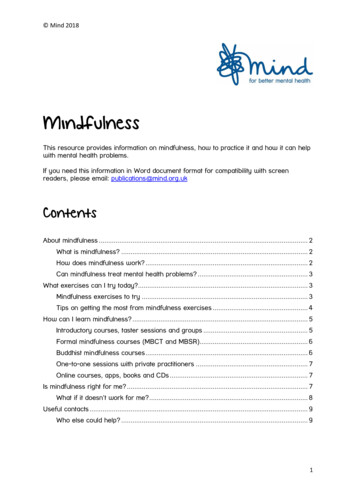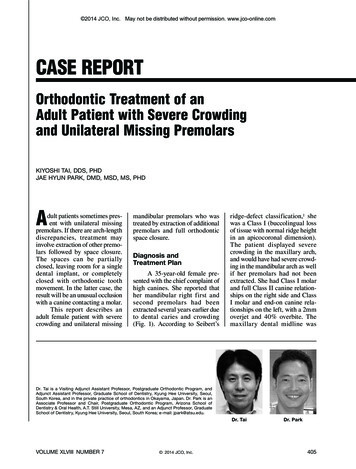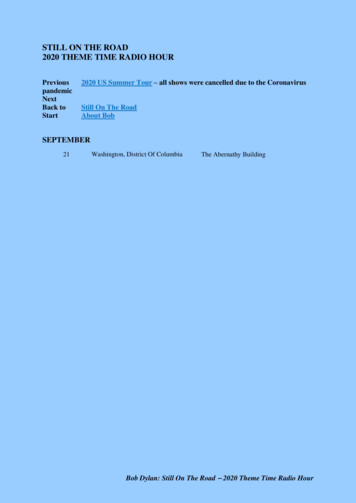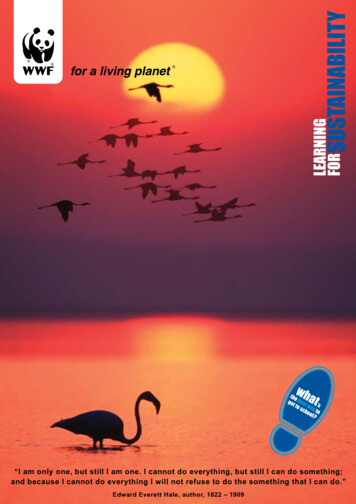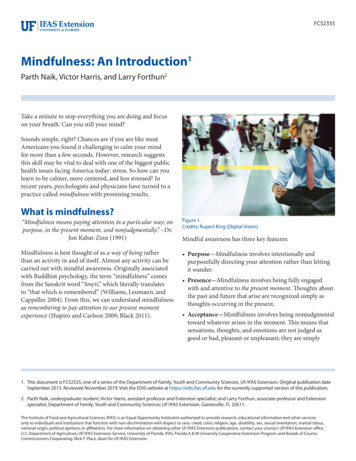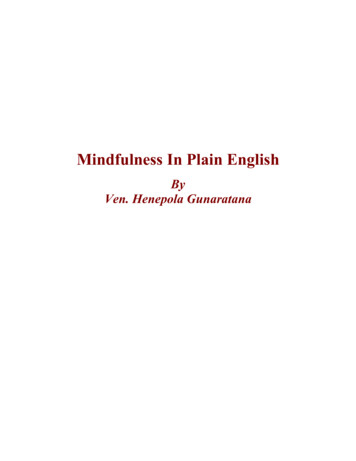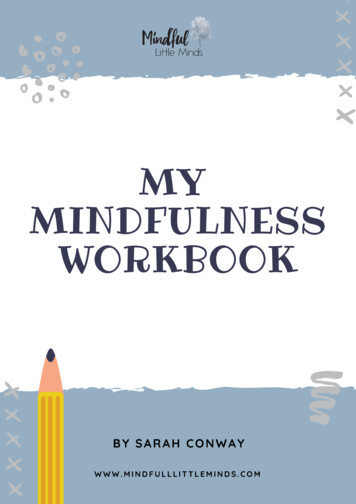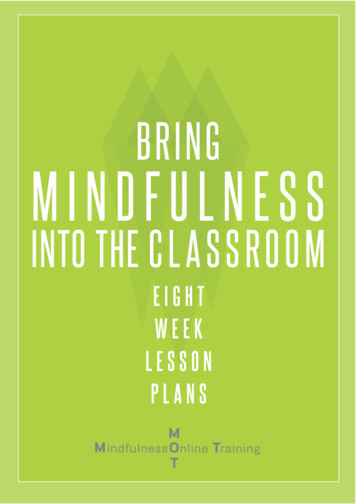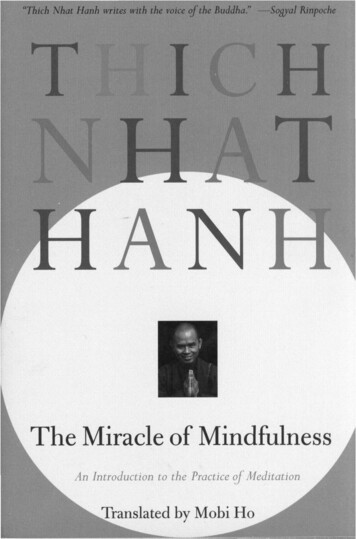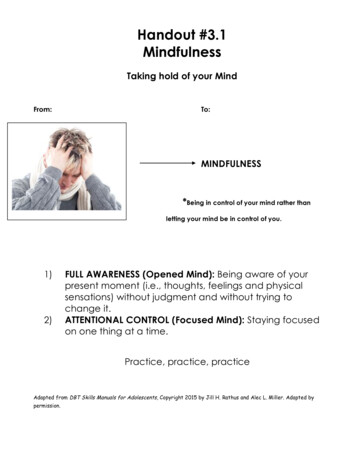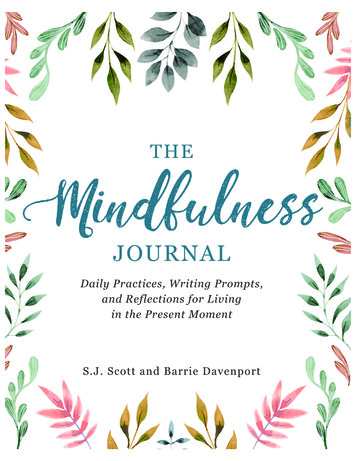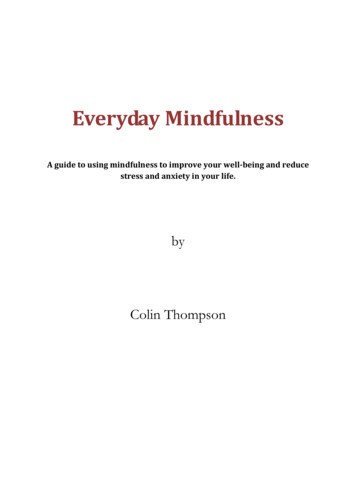
Transcription
Everyday MindfulnessA guide to using mindfulness to improve your well-being and reducestress and anxiety in your life.byColin Thompson
Notes to readers.1. This book has a number of web links embedded in the text and are underlined toindicate a link. If you have a printed copy of this book and don‘t want to type the linksthen you can access them at www.stillmind.com.au/MindfulnessbookLinks.htm.2. I welcome feedback in any form. If you are new to mindfulness, I would be particularlyinterested to hear about passages that you found difficult to understand. Those familiarwith mindfulness might want to question my ideas. Feedback in any form tocolThompson@gmail.com is welcome.About the AuthorColin Thompson is a psychologist and counsellor in private practice in Melbourne, Australia. Hispractice is largely based around teaching people how to use mindfulness to live fuller andhealthier lives. He has practised Buddhist meditation for thirty years, currently in the Zentradition. His website is www.stillmind.com.auContents1 Introduction2 Benefits of Mindfulness3 Mindfulness Practice4 How does Mindfulness Work?5 Mindfulness Practice in Daily Life6 Using Mindfulness in Difficult Situations7 Thoughts, Emotions and Body Sensations8 Stress9 Mindful Movement10 Deeper Benefits of MindfulnessReferencesEd 329 April 20102
IntroductionWhat is this thing called mindfulness . Has it been around for thousands of years . How can ithelp me? This book is about answering these questions.Mindfulness is a time-honoured way of improving your well-being, happiness and sense offulfilment. It has been shown to reduce depression, anxiety, substance abuse and even pain. Thepractice of mindfulness was developed in India over 2500 years ago. It was part of a path toenlightenment and awakening and most religions including Hindu, Buddhism, Christianity andIslam have meditation traditions. These ancient techniques of meditation have recently beenadapted to address twenty first century pressures of modern living, and that‘s what this book isabout.Have you ever felt a bit down, maybe upset about what someone said to you or perhaps anxiousabout a meeting in a few days time? Possibly you‘ve found your thoughts running out of controlor you worry a fair bit. Maybe you even have a serious disease, are in pain, or suffering from amental illness such as depression or schizophrenia? Mindfulness may help in all these situations.So what does it mean to be mindful? As a child I was occasionally told, ―Mind your manners‖.This I think meant that I should be aware of what I was doing and how it was affecting otherpeople – usually adults! That‘s not a bad start, mindfulness certainly is about paying attention.Paying attention to what is happening right now, right before our eyes . and ears and noses andother senses, including our internal ones. What pains and tensions are there in my body, how amI feeling right now, am I aware of what I am thinking or am I on automatic, daydreaming, orperhaps going over and over a difficult encounter?Many of the problems mentioned above relate to the future or the past. Anxiety and stress canresult from worrying about future events. Depression is often associated with replaying pastevents in our mind. We go over past events or are anxious about the future. Much of ourthinking is not in the present, and the present is the only time we‘ve got – a series of presentmoments.By moving our life more into the present moment, we relate to the past and the future in adifferent way and our habitual unhelpful thinking about past and future events drops away,becomes less insistent, and we find right here, right now a more vibrant and alive place to be. ―SinceI‘ve been practising mindfulness, I‘ve regained a lot of the energy spent fighting off sadness andanger, my mind is much clearer now,‖ said one client. ―The flowers seem brighter,‖ said anotherwith a puzzled expression on her face.Tuning in to the present moment is where sensations come in – a sensation is always in thepresent. Feel your legs and buttocks pressing on the chair for a few seconds . listen carefully toany sound nearby. Congratulations, you have just been practising mindfulness! By doingmindfulness exercises based around sensations (e.g. the breath) and by becoming more aware inour daily life of what‘s going on around us, we can spend more time in the present.3
When our habitual repetitive worry or anxious thinking fades we find we have more time andenergy for what our brain was made for: creativity, problem solving, appreciating music to namea few.So, is that it? Observe my sensations, live in the present and all my problems evaporate? Almost.There‘s two aspects to mindfulness. Siddhartha Gautama, known as the awakened one, or theBuddha, spoke of mindfulness as ―Seeing things, as they are, right now‖. John Kabat-Zinn, thefather of modern mindfulness therapy, paraphrases this as ―Paying attention to the presentmoment – non-judgementally‖. Observing without judgement is the second aspect ofmindfulness.Have you ever thought, ―What‘d I say that for? That was stupid‖, or imagined all the things thatmight go wrong in a future situation or maybe in your life? Perhaps you even have a stronginternal critic commenting on most of your actions. ―She wouldn‘t go out with someone likeyou,‖ or ―That‘s much too difficult to even try.‖These are all judgements. We are a judging species. Often it‘s how we change and head in theright direction. We are about to enter a dark street at night. A combination of fear andjudgement allows us to come up with a decision on how to proceed. Our habit of judging can letus down however as when a student attends a lecture and doesn‘t quite understand the first fiveminutes. She thinks, ―This is too hard‖, and feels a little nervous. As a result she cannotconcentrate so well. She misses the next couple of lines and thinks (judges herself), ―I‘ll neverunderstand this‖, resulting in more anxiety. ―If I don‘t understand it perfectly, I must be dumb‖is accompanied by a sinking feeling in the stomach. ―Why am I so stupid?‖ Eventually to givesome sense of relief to her anxiety, she leaves the lecture. It is these self judgements that havesnowballed and brought on anxiety, a nagging feeling in her stomach and perhaps a sense ofunworthiness.In many small ways too, we are constantly judging: this tastes nice, that looks awful, such abeautiful flower, it‘s horrible feeling this way. The point is, it becomes a habit and we don‘tnotice ourselves doing it, especially in self judgements. And many of these self judgements, as inthe case of the student, are unhelpful. They don‘t lead to anything positive; they don‘t lead tolife.Even positive judgements can take us away from the immediacy of a situation. As I sit outsidewriting this, early jasmine is in full bloom, filling my garden with its scent. If I have the thought,―How beautiful!‖, it puts a small space between me and the experience. Just being with thejasmine is vibrant, life affirming. There‘s no need to stop saying ―How beautiful‖, just note thedifference in these two ways of relating.In following the mindfulness approach, you‘ll be invited to observe your breathing as it is rightnow, shallow, deep, relaxed, whatever; breath coming in, breath going out. No need for judginghere. You‘ll be similarly invited to choose daily tasks to do with full awareness, such as brushingyour teeth, perhaps realising how automatically you have done them in the past. You‘ll graduallybecome aware (if you were not already) of your own ―favourite‖ negative judging thoughts andsee them for what they really are, just thoughts you happen to be thinking right now, not ideas tobe believed uncritically.4
As a result you may find negative thinking drops away, resulting in less anxiety and stress.Depression might lift. Even pain can cause less suffering when you start being mindful of itrather than fighting it or wishing it less.So that‘s what this book is about, how to deal with life‘s issues and live a fuller, more vibrant lifeby staying in the present. Simple? Yes. Easy? No.You can find an introductory discussion of mindfulness by the gentle Vietnamese monk, ThichNhat Hanh at http://www.youtube.com/watch?v aubF7v-MlMM.That‘s another thing aboutthis book; it has a lot of links to further material on the internet. References are listed at the end,but in most cases they are also embedded in this text and are underlined to indicate a link. If youhave a printed copy of this book and don‘t want to type the links then you can access them is book takes you in stages through the practice of mindfulness. First I discuss some of thebenefits of mindfulness, such as improved well-being, a more stable and balanced mind and areduction in stress and anxiety. In chapter three, Mindfulness Practice, you will learn how topractise mindfulness of the breath, do a body scan and also how to establish your ownmindfulness practice. Breath awareness simply means sitting comfortably and paying attention tothe breath as best you can for a few minutes. This often results in people finding how manythoughts they have bouncing around in their head, often banal or self-critical thoughts. Thoughtslead to more thoughts, especially if you pay attention to them or believe them. By focussing onsome sensation, in the present, unhelpful thoughts are starved of oxygen. Slowly, as the thoughtsare not fed, their influence wains and often the number of thoughts reduce and you feel a littlecalmer and more in control. Insight into the mind and its habits grows.The body scan practice, on the other hand, puts us in touch with our body, its tensions andstresses. As these are frequently connected to emotions it gives us the ability to learn more aboutour feelings and in particular to cope with troublesome emotions better.Chapter four discusses why sitting and observing can be so beneficial and lead to peace andtranquillity. It explains how unhelpful thoughts lose their power and why feeling our feelingsworks better than fighting or ignoring our feelings.While the formal mindfulness practices of breath and body awareness are very helpful, it isimportant to connect them with daily activities, and that is the subject of chapter five. Here, youwill learn how to practise mindfulness in everyday situations such as brushing your teeth oreating a meal. Mini-mindfulness practices are introduced that may be practised regularlythroughout the day. All this is the more formal part of the practice, but it is important to learnhow to use mindfulness in difficult life situations, and so in chapter six, we look at a few ofthese, such as those leading to depression and anger.Thoughts, emotions and body sensations are important aspects of the mind, and chapter sevenshows how these develop as a difficult situation evolves. Instead of getting overwhelmed andupset, this chapter demonstrates how you can work with each aspect to gain control of yourmind and not allow the situation to spiral out of control.5
In the next chapter, we see how stress occurs and how mindfulness may help in its managementto prevent normal stress developing into chronic stress. Chapter nine, Mindful Movement,discusses the benefits of walking meditation, yoga and exercise – all done mindfully of course.Mindfulness was developed for much more than dealing with difficult situations in life. It is awhole philosophy of life and if you are inspired to look further into this aspect then the finalchapter, Deeper Benefits of Mindfulness, gives you some pointers.While this book will get you started, it is useful to obtain help from a good teacher throughoutthe process. A teacher can help you establish a practice and lead you towards using mindfulnessto deal with your specific life difficulties. Ideally you would look for a teacher with a strongmindfulness practice of their own, and who is also skilled in some form of psychotherapy so thatthey can show you how to apply mindfulness to your personal life situation and help guide yourpractice.Introduction – Summary Everyday Mindfulness describes how you can use the ancient techniques of mindfulnessin a modern day context to deal with difficult situations in your life, and experience anincreased enjoyment and sense of well-being. It may also inspire you to seek furtherand discover the deeper experiences of mindfulness and meditation in general. It will also be of help to health professionals who want to understand better howmindfulness can help their clients. Mindfulness means paying attention to the present moment, non-judgementally and inso doing fully experiencing life. You will learn various formal mindfulness practices such as mindfulness of the breath,the body scan and mini-mindfulness exercises, as well as how to use mindfulness indifficult situations such as those provoking stress and anxiety. You will learn how to work with your thoughts, emotions and body sensations. /Mindfulnessbook.htm linksthecanwebbe foundatat6
2. Benefits of MindfulnessNo-one is likely to start something new unless they have a reason. So let‘s talk straight awayabout the benefits of becoming more mindful. Benefits fall broadly into three areas: well-being,mental benefits and therapeutic benefits. Well-being benefits include having more energy orperhaps enjoying a walk in the local park more, while mental benefits include an increased selfunderstanding and stability of the mind. Therapeutic benefits are seen in areas such asdepression, anxiety, schizophrenia and pain, all of which can be improved with a mindfulnesspractice.Well-BeingPeople who practise mindfulness regularly, talk of a number of improvements in their life. Oneclient told me her practice was an ―island of peace‖ in her stressful day where she could leave herconcerns behind for a time. Others talk of seei
Mini-mindfulness practices are introduced that may be practised regularly throughout the day. All this is the more formal part of the practice, but it is important to learn how to use mindfulness in difficult life situations, and so in chapter six, we look at a few of these, such as those leading to depression and anger. Thoughts, emotions and body sensations are important aspects of the mind .
